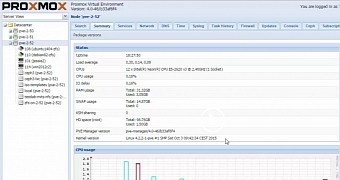Proxmox VE (Virtual Environment) project leader Martin Maurer is pleased to announce today the release and immediate availability for download of the Proxmox VE 5.0 operating system.
Based on the recently released Debian GNU/Linux 9 "Stretch" operating system, Proxmox 5.0 "Virtual Environment" is here to introduce a bunch of new functionalities and under-the-hood improvements, and the biggest of them all is the implementation of a new Proxmox VE storage replication stack.
"Replicas provide asynchronous data replication between two or multiple nodes in a cluster, thus minimizing data loss in case of failure. For all organizations using local storage the Proxmox replication feature is a great option to increase data redundancy for high I/Os avoiding the need of complex shared or distributed storage configurations," says Martin Maurer in today's forum release announcement.
Ceph RBD becomes the de-facto standard for distributed storage
Other noteworthy changes implemented in this major release of the Proxmox "Virtual Environment" operating system, we can mention Ceph RBD as the de-facto standard for distributed storage, which is now maintained in-house by the Proxmox team, and a new command-line tool called "qm importdisk" for simplifying the import of disks from various hypervisors, including Microsoft's Hyper-V and VMWare.
Proxmox 5.0 "Virtual Environment" also ships with other interesting features like live migration with local storage via the QEMU virtualization software, USB and Host PCI address visibility, as well as filtering and bulk actions options in the GUI, an optimized NoVNC console, and the availability of Ceph Luminous for testing. Numerous other bugs and issues were fixed, and you can download the Proxmox VE 5.0 installation image right now from our website if you want to upgrade your Proxmox Virtual Environment.

 14 DAY TRIAL //
14 DAY TRIAL //